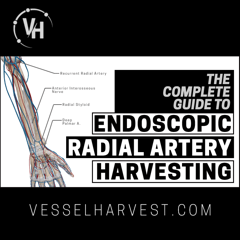The Complete Guide to Endoscopic Radial Artery Harvest
The radial artery has proved to be a superb conduit for CABG, but the procedure remains mysterious and nerve-wracking to most harvesters. But it doesn’t have to be.
Overcome any intimidation or uncertainty and learn everything harvesters need to know about ERAH with The Complete Guide to Endoscopic Radial Artery Harvesting. Includes 365 days of mobile and desktop access, badge lanyard, and lapel pin. Satisfaction guaranteed.
Eligible for 12 hours AMA PRA Category 1 CreditTM.
Cost: $629.00Add to cart
Key Features
Comprehensive endoscopic radial artery harvesting course: 5 chapters of video lessons with discussion, demonstration, annotated video, graphics, and journal references.
Topics Covered
We cover the history of radial use, review of published patency rates of IMA vs. Radial artery vs. Saphenous vein, in-depth review of radial artery & forearm anatomy, preoperative testing, procedure step-by-step, wound closure, postoperative care, procedural troubleshooting, initial & follow up complaints/concerns, and next steps as a Radial Artery Harvester.
Learning Objectives
Discuss the purpose of performing endoscopic radial artery harvesting, background of the procedure, and historical origins for reference, Decide on appropriate patient selection for the procedure, Explain the preoperative testing modalities, Describe the importance of adequate evaluation of the patient and documentation of findings prior to surgery, Review how to prep and position the arm for successful radial conduit harvesting, Compare the three most commonly used endoscopic devices and how to use each during a radial artery harvest, Detailed explanation each step of the procedure, including open dissection, scope dissection, scope harvest, removal, and hemostasis of the procedure along with troubleshooting common intraoperative findings, State how to prepare the artery after harvest for bypass use, ideal wound closure techniques, and wound care management, Explain how to manage common intraoperative complications as well as evaluation and management of short-term and longer-term complications from the procedure, Explain how to manage common intraoperative complications as well as evaluation and management of short-term and longer-term complications from the procedure.
Target Audience
Physicians, Physician Assistants, Nurse Practitioners, Perfusionists, RN First Assists, and Surgical Technologists

